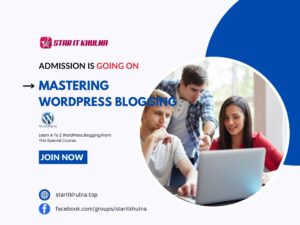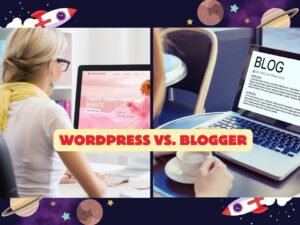Introduction
WordPress has become synonymous with blogging and content management systems (CMS) for millions of users worldwide. It offers a versatile platform that caters to beginners and seasoned bloggers alike, combining user-friendliness with powerful features. In today’s digital landscape, WordPress stands tall as the cornerstone of modern blogging. Whether you’re a budding wordsmith or a seasoned content connoisseur, WordPress offers an unparalleled blend of versatility, power, and user-friendliness that sets it apart from the crowded realm of content management systems. What makes WordPress the undisputed champion for bloggers? It’s not just about crafting compelling posts; it’s about sculpting a digital presence that captivates and converts. Imagine a platform where seamless setup meets endless customization possibilities. From its intuitive interface to robust plugins that turbocharge SEO and foster reader engagement, WordPress empowers you to transcend mere blogging and embark on a journey of digital storytelling mastery. Whether you’re dreaming of monetization avenues or craving deeper reader connections, this guide will unveil how WordPress transforms aspirations into achievements. Ready to unleash your creativity and conquer the blogosphere? Let’s dive into why WordPress isn’t just a platform—it’s your launchpad to digital success.
Getting Started with WordPress
Setting up your WordPress blog involves several key steps that lay the foundation for your online presence. Choosing a reliable hosting provider is crucial for ensuring your site’s performance and reliability. Installing WordPress is a straightforward process that typically takes only a few minutes. Once installed, configuring basic settings such as site title, tagline, and permalink structure helps optimize your blog’s functionality from the outset.
Understanding WordPress Dashboard
Navigating the WordPress dashboard gives you access to all the tools and settings you need to manage your blog effectively. Key elements like the dashboard sidebar, which houses menus for posts, media, pages, and comments, streamline content management. Customizing dashboard widgets allows you to personalize your workspace by adding quick-access tools for site statistics, recent comments, and more.
Choosing the Right Theme
Selecting a theme sets the visual tone for your blog and affects user experience. A responsive theme is essential for ensuring your site looks great and functions well across all devices. While free themes offer cost savings, premium themes often provide additional features and dedicated support. Popular themes among bloggers include minimalist designs, magazine layouts, and niche-specific options tailored to various industries.
Essential Plugins for Bloggers
Enhance your blog’s functionality with essential plugins that cater to specific needs. SEO optimization plugins help improve your site’s visibility in search engine results. Plugins for social sharing and engagement encourage interaction and expand your blog’s reach. Backup and security plugins provide peace of mind by safeguarding your content against data loss and malicious attacks.
Creating Compelling Blog Posts
Crafting engaging blog posts involves more than just writing. Formatting your content with headings, paragraphs, and bullet points improves readability. Enhance your posts with images, videos, and other media to enrich the reader’s experience. Using categories and tags effectively organizes your content, making it easier for visitors to navigate your blog and discover related topics.
Mastering SEO with WordPress
Understanding SEO basics is essential for driving organic traffic to your blog. WordPress offers plugins and tools that simplify SEO tasks such as keyword optimization, meta tag management, and XML sitemap creation. Optimizing content for search engines involves strategic placement of keywords, creating valuable content that answers reader queries, and earning backlinks from reputable sites.
Growing Your Audience
Building an email list through WordPress enables direct communication with your audience, fostering relationships and driving repeat traffic. Integrating social media platforms like Facebook, Twitter, and Instagram amplifies your content’s reach and encourages user engagement. Implementing strategies such as guest blogging, participating in online communities, and collaborating with influencers can significantly increase your blog’s visibility and attract new readers.
Monetizing Your Blog
Explore various monetization options to generate revenue from your WordPress blog. Setting up and optimizing Google AdSense allows you to display targeted ads that align with your content and audience interests. Implementing affiliate marketing strategies involves promoting products or services and earning commissions on sales generated through your referral links. Additionally, selling digital products, offering online courses, or providing consulting services can diversify your income streams.
Advanced Customization Techniques
Customizing WordPress themes using CSS empowers you to personalize your site’s appearance and functionality beyond theme defaults. Creating child themes preserves customizations during theme updates while allowing for further modifications. Page builders offer intuitive drag-and-drop interfaces for designing custom layouts without coding, enabling you to create unique page designs tailored to your specific needs.
Managing Multiple Contributors
Efficiently manage multiple contributors by assigning appropriate user roles and permissions within WordPress. Collaborative tools facilitate seamless communication and task management among team members, ensuring cohesive content creation and publication workflows. Implementing best practices for editorial workflows streamlines content review, approval, and scheduling processes, maintaining consistency and quality across your blog.
Ensuring Security and Backup
Implementing WordPress security best practices protects your blog from potential threats and vulnerabilities. Setting up automated backups ensures that your content and data are regularly saved and can be restored in the event of data loss or site compromise. Familiarizing yourself with common security measures such as using strong passwords, updating plugins and themes regularly, and limiting login attempts enhances your blog’s overall security posture.
Optimizing Performance
Enhance your WordPress site’s speed and performance to provide visitors with a smooth and responsive browsing experience. Implementing caching strategies reduces load times by storing static versions of your site’s pages. Testing and optimizing for mobile users ensures that your site remains accessible and user-friendly across smartphones and tablets, catering to the increasing number of mobile internet users.
Integrating E-commerce with WordPress
Expand your blog’s capabilities by integrating e-commerce functionality using WordPress plugins. Choosing the right e-commerce plugin, such as WooCommerce, enables you to set up and manage an online store seamlessly. Optimizing product pages for conversions involves compelling product descriptions, high-quality images, user reviews, and streamlined checkout processes that minimize friction and maximize sales.
Expanding Functionality with Widgets and Menus
Enhance your blog’s functionality and navigation by using widgets to add dynamic content to your sidebar, footer, or other widget-ready areas. Creating custom menus enables you to organize and structure your site’s navigation to improve user experience and accessibility. Integrating third-party widgets and plugins extends your blog’s functionality by adding features such as social media feeds, related posts, and interactive elements that engage and retain visitors.
Engaging with Your Readers
Encourage interaction and feedback from your audience to build a community around your blog. Promoting comments and feedback on your posts fosters discussion and allows readers to share their thoughts and insights. Using contact forms provides a convenient way for readers to reach out to you privately for inquiries, collaborations, or feedback. Implementing live chat support offers real-time assistance to visitors, enhancing their overall experience and satisfaction.
Analyzing Your Blog Performance
Track and analyze your blog’s performance using tools like Google Analytics to gain insights into visitor behavior, traffic sources, and content performance. Understanding key metrics such as bounce rate, average session duration, and conversion rates helps you assess the effectiveness of your blogging strategies. Using data-driven insights allows you to identify opportunities for improvement, refine your content strategy, and optimize your blog for greater success.
Staying Updated with WordPress
Stay informed about updates to WordPress core, themes, and plugins to ensure your blog remains secure, stable, and compatible with the latest technologies. Understanding WordPress release cycles helps you anticipate new features, enhancements, and improvements that can benefit your blog’s performance and functionality. Following WordPress blogs and communities keeps you connected with industry trends, best practices, and community support, providing valuable resources and insights for continuous learning and growth.
Troubleshooting Common WordPress Issues
Resolve common WordPress issues such as errors, plugin conflicts, or performance issues to maintain your blog’s functionality and user experience. Troubleshooting plugin conflicts involves deactivating plugins one by one to identify the culprit and seeking support from the WordPress community or plugin developers for solutions. Accessing support forums, documentation, and online resources offers guidance and troubleshooting tips from experienced users and developers.
Conclusion
WordPress stands out as the preferred platform for bloggers due to its versatility, user-friendly interface, and extensive customization options. Whether you’re starting your first blog or managing a growing online presence, WordPress provides the tools and resources you need to succeed. By leveraging its robust features for blogging, SEO, audience engagement, and monetization, you can create a dynamic and successful blog that resonates with your audience. Explore the endless possibilities that WordPress offers, and embark on your blogging journey with confidence and creativity.





